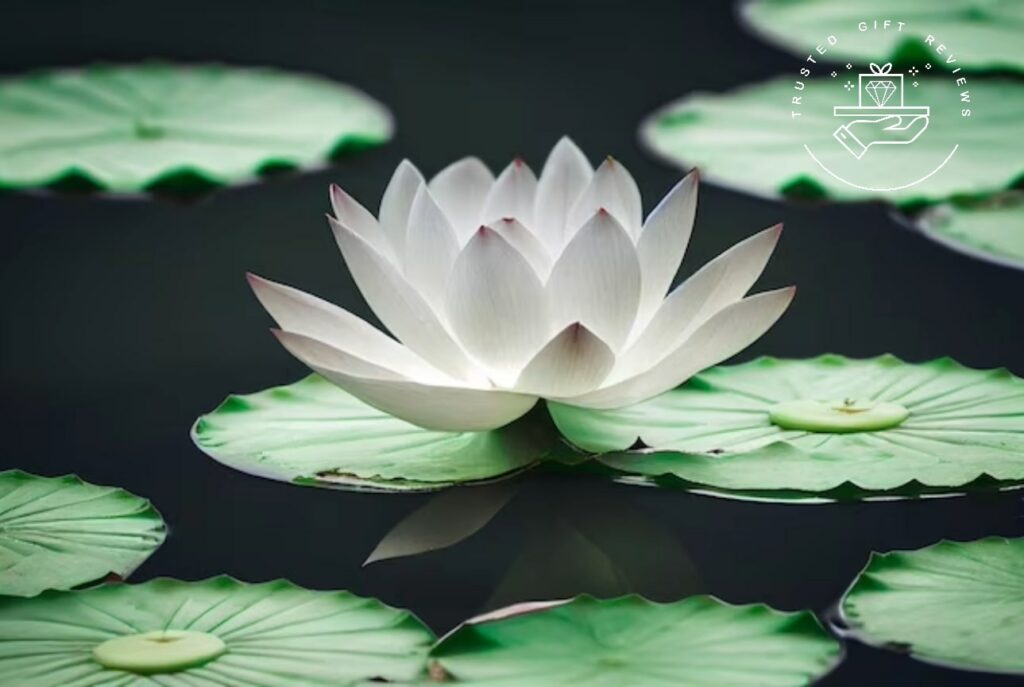The pristine beauty of the white lotus flower is sacred in many cultures and religions around the world. It has been a symbol of enlightenment, mental purity, and spiritual perfection.
In this article, we will discuss this flower’s meanings and the many ways that you can use it in your everyday life.
How did the white lotus flower get its name?


The word “lotus” comes from the Greek word “lotos,” which was used to describe a variety of plants with large, extravagant flowers.
What are the botanical origins of the white lotus flower?


The white lotus flower, scientifically known as Nymphaea lotus, is a perennial that comes from the Nymphaeaceae family and is native to different parts of East Africa and East Asia.
Where do white lotus flowers grow?
White lotus flowers flourish in freshwater environments, including ponds, lakes, and slow-flowing rivers. They prefer warm and temperate climates with high water temperatures.
Do white lotus flowers require a lot of maintenance?
White lotus flowers are remarkably low-maintenance plants. Once they’re established in their habitat, they don’t need conventional watering, unlike other terrestrial plants.
Just be sure to prune any dead or decaying parts to preserve the vitality and vibrancy of your white lotus flowers.
Do white lotus flowers need shade or sun?
White lotus flowers thrive in the full sunlight. They need a minimum of six hours of direct sunlight to flourish and bloom more often.
When do white lotus flowers bloom?
White lotus flowers usually bloom during the warmer months of the year, often in late spring and through the summer.
The exact timing can vary depending on the geographical region and prevailing climate conditions.
What kind of soil do white lotus flowers prefer?
For those who want to grow white lotus flowers in garden ponds or containers, it’s best to use a blend of loamy soil and clay to mirror their natural environment.
It’s also important to ensure they receive essential nutrients through regular fertilization, using fertilizers for aquatic plants.
What kind of water do white lotus flowers prefer?
White lotus flowers thrive in still, shallow waters with a depth ranging from 2 to 18 inches. Their root systems can thrive in mucky or silty substrates.
The water should be free from strong currents, which can harm their delicate petals and interfere with their development. Also, be sure to maintain the cleanliness of the water to prevent the accumulation of debris that might affect their growth.
When is the best time to plant white lotus flower seeds?
The best time for planting white lotus flower seeds is in the early spring, once the last frost has subsided.
Before sowing them, it’s best to scarify or soak the seeds in warm water to facilitate the germination process.
For optimal growth, plant the seeds in a container and place them in a shallow pond or container with water temperatures exceeding 70°F (21°C) to establish the most favorable conditions for successful development.
What do white lotus flowers mean?


White is one of the most popular colors of lotus flowers. It signifies many things, including beauty, grace, purity of mind, wealth, knowledge, fertility, and faith.
In Buddhism, the white lotus flower stands as a beacon of spiritual enlightenment and mental clarity, embodying the pursuit of Bodhi or being awakened.
Chinese tradition also embraces the white lotus for its representation of harmony and grace..
What are the cultural associations of white lotus flowers?


What are the spiritual or religious meanings of white lotus flowers?


What are the uses of white lotus flowers?


The white lotus flower is valued not only for its rich symbolism but also for its practical use in cooking and medicine.
How can white lotus flowers be used in cooking?


All parts of the white lotus flower are edible. Here are some ways you can use them in your kitchen:
- Petals: The petals of the white lotus flower are used in Indian, Chinese, and Vietnamese dishes such as nelum ala curry, lo mai gai, and goi ngo sen.
Their unique flavor complements both sweet and savory food and enhances the overall flavor balance. White lotus petals are also frequently used as garnishes for desserts, salads, and other cuisines.
- Seeds: The lotus flower seeds have a range of different uses. They have a rich protein content and minimal calorie count, which makes them a great alternative to conventional snacks.
These seeds are often roasted and seasoned with an array of spices to become a flavorful, satisfying treat. Lotus flower seeds are also a sought-after addition to traditional desserts and savory dishes for their crunchiness.
- Leaves: Lotus leaves can be used to serve food. These leaves have natural hydrophobic and self-cleaning properties, which can effectively repel water and prevent food from sticking to the surface.
They’re also believed to have anti-inflammatory and antioxidant properties. In addition, the unique fragrance of the lotus leaf can elevate anyone’s dining experience.
- Roots: The lotus root is a versatile ingredient that has been enjoyed by both royalty and common men throughout history. It can be peeled, sliced, and consumed raw or cooked.
Lotus root can be prepared in many ways, such as deep-frying, stir-frying, or simmering it in soups and stews. You may also see stuffed lotus root in some culinary preparations.
Soy sauce and lotus root is a popular combination for an array of dishes. Additionally, lotus root can be enjoyed in the form of tea.
Can white lotus flowers be used for medicinal purposes?


Yes, different parts of the lotus flower have been used to treat various ailments and promote well-being.
- Traditional Chinese Medicine: In traditional Chinese medicine, various parts of the white lotus plant are used.
The petals of the flower are known for their cooling and astringent properties, which makes them valuable for addressing conditions like diarrhea, fevers, and bleeding.
The white lotus is often linked with the heart and is known for the calming and soothing qualities of its stamen when eaten or used in medicine.
The lotus root, on the other hand, is used to strengthen the spleen, promote digestive health, and support lung function.
- Ayurveda: In an ancient Indian system of healing called Ayurveda, the lotus is believed to have cooling and soothing properties that benefit both the body and the mind.
It’s used in alleviating conditions related to the digestive and respiratory systems, such as diarrhea and dysentery.
It’s also believed to reduce stress and promote relaxation.




